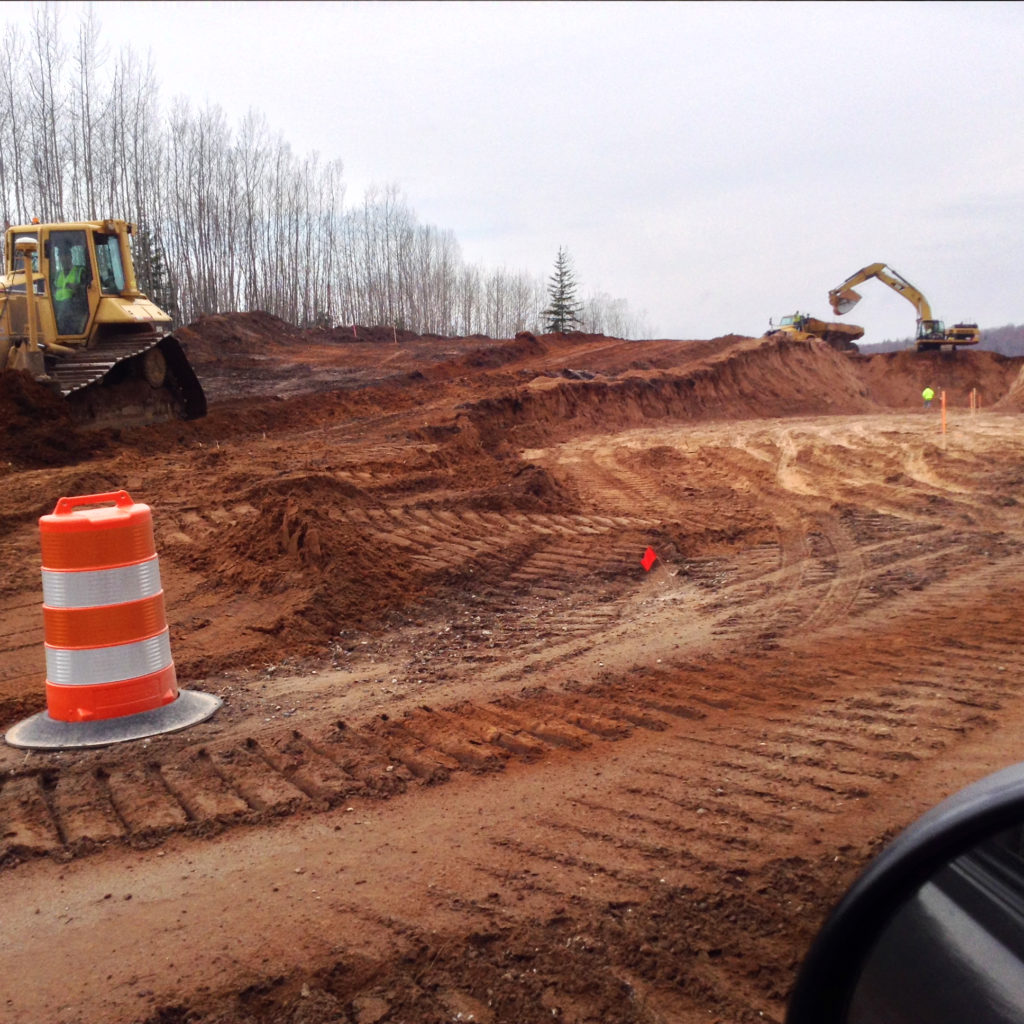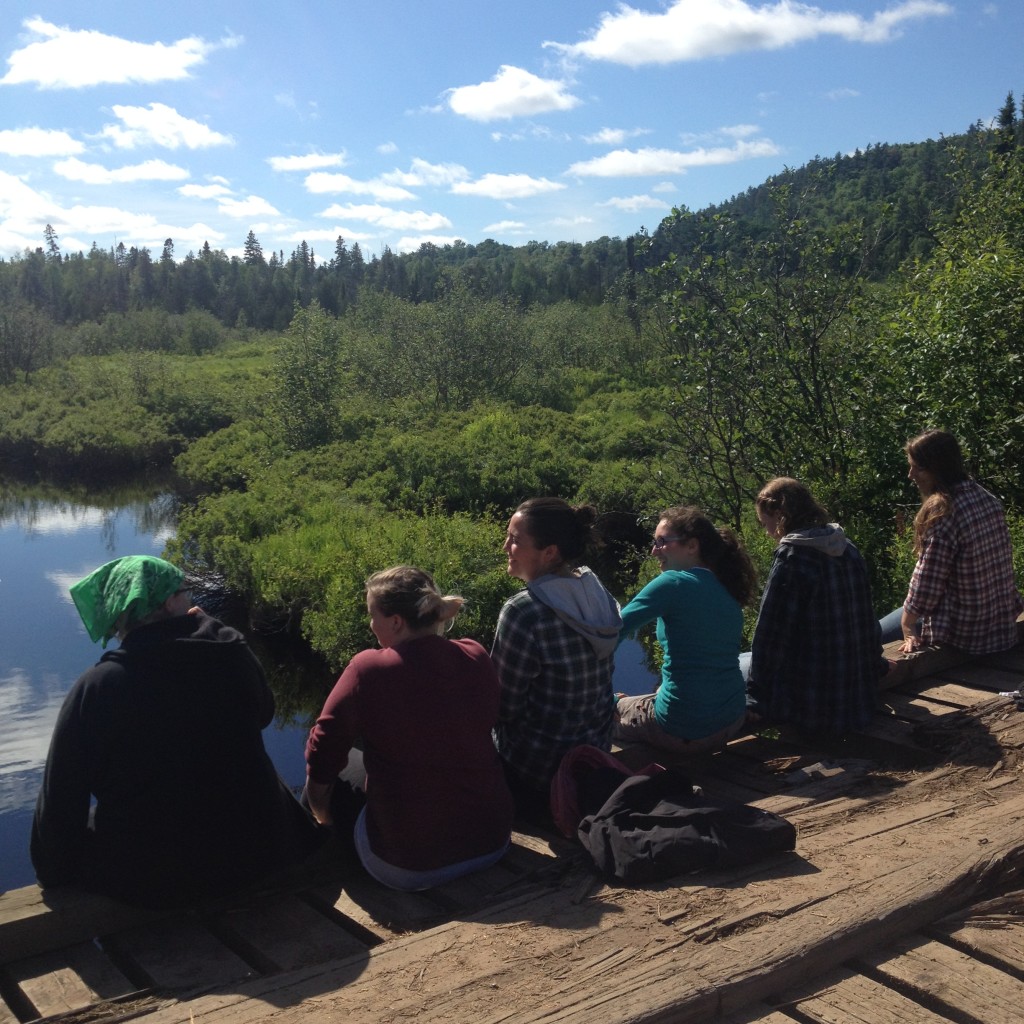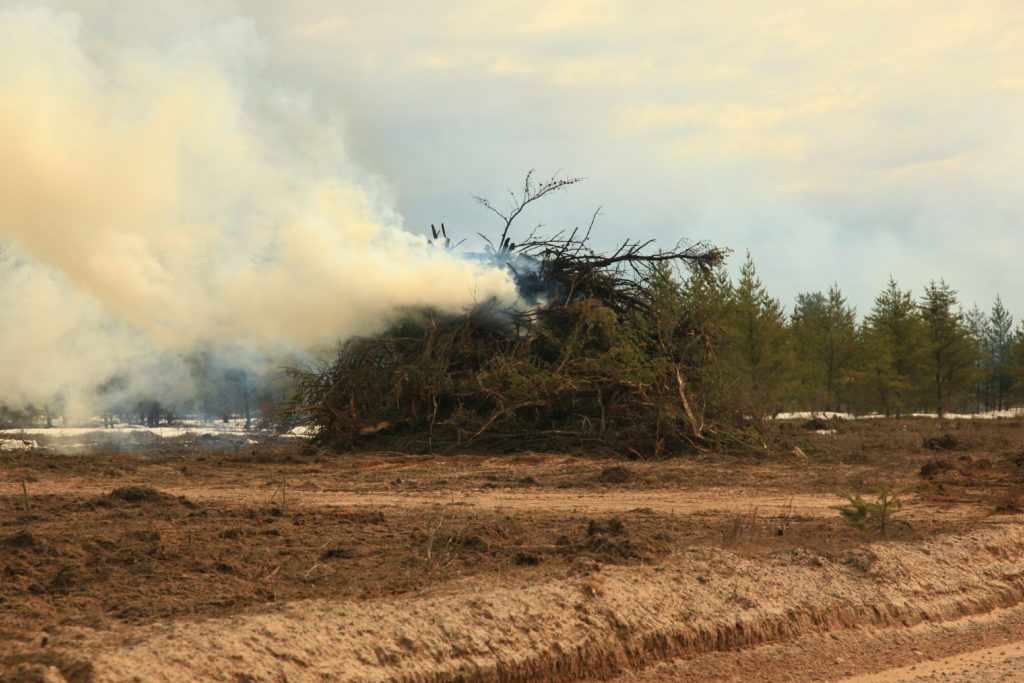Marquette County Road Commission v. Environmental Protection Agency
Regional environmentalists are dismissing as “wildly inaccurate” an article published in the Wall Street Journal (*1) on March 3rd, entitled “How a Michigan County Road Got Stuck in Regulatory Purgatory”. The piece, co-written by two lawyers working on the Marquette County Road Commission (MCRC) lawsuit against the Environmental Protection Agency (EPA) “relied on ‘alternative facts’ and amounted to little more than a highly-placed publicity stunt,” according to Kathleen Heideman, a Board member of the Upper Peninsula Environmental Coalition’s (UPEC) Mining Action Group.
The Wall Street Journal story plays fast and loose with the facts, according to Heideman, suggesting that the road proposal is a “shovel-ready” jobs initiative caught in “regulatory purgatory” and that the EPA was “vague” in their wetland objections, which ultimately “vetoed” a critical road building project.
In fact, the mine’s original (permitted) transportation plan matches the mine’s current haul route, and the “short cut” was only concocted after the mining company purchased the Humboldt Mill property for processing and refining their ore. The so-called “shovel ready” plan failed to clear the review of multiple federal agencies, including EPA, the U. S. Army Corps of Engineers, and the U. S. Fish and Wildlife Service. Previously, the mining company told regulators that they would use “existing infrastructure” and develop a rail depot north of the city of Marquette. “Groggy college students” would not have been endangered by Eagle Mine’s original plan.
“REGULATORY PURGATORY”? A FACTUAL HISTORY OF CR-595
From the beginning, environmentalists have contended that the Road Commission was trying to build an industrial road – a mining haul road for the benefit of a single company – rather than a County Road designed to benefit the public. “The Pacific Legal Foundation is attempting to recast this issue as an anti-EPA “states rights” issue, and revising history as they go. The facts of the case simply do not support their claims,” said Steve Garske, UPEC Board member and member of the Mining Action Group.
The CR-595 proposal was controversial from its first incarnation as the privately-funded “Woodland Road” proposal, which the owners of Eagle Mine (then Rio Tinto) offered to fund. Promoters of the “Woodland Road” claimed its main purpose was to provide local citizens with easier access to the roadless interior of Marquette County for hunting, fishing, berry-picking, and other recreational activities, while dodging massive ore trucks. Federal agencies objected to the “Woodland Road” plan on the grounds that impacts to wetlands and streams were poorly quantified, and because the road’s stated purpose was highly inaccurate.
Contrary to the Wall Street Journal article, the objections raised by federal agencies were always quite specific, as seen in early March 2010: “The application must quantify aquatic impacts, especially the following: the loss of headwaters and wetlands associated with headwaters, in each watershed; the loss of rare wetland plant communities, including bogs, fens and wet meadows; and water quality degradation due to runoff containing pollutants, and clearly indicate how the loss of each of these features would be compensated. This is necessary to allow (Michigan environmental regulators) to fully evaluate whether compensation is possible for the unique functions lost within each of the four watersheds… Woodland Road application is deficient in several areas, including reasonable comparison of alternative routes, an adequate 404(b)(1) analysis, and an adequate compensatory mitigation proposal.” (*2)

Remote Mulligan Creek wetlands complex, at the site of the proposed CR-595 crossing, photograph by Amy Cherrette (2016).
Woodland Road was later renamed “County Road 595”; the proposed route would have cut through 22 rivers and streams, including the Dead River and Yellow Dog River Watersheds, Mulligan Creek headwaters, Voelker Creek, and Wildcat Canyon Creek, destroying approximately 25 acres of wetlands, directly impacting 122 wetland complexes, and bisecting a major wildlife corridor, fragmenting both habitat and hydrology.
“The EPA’s decisions were not ‘arbitrary and capricious’ as the Road Commission has contended. Instead, they were in alignment with the concerns of the other state and federal agencies charged with protecting our natural resources,” said concerned citizen Catherine Parker.

Narrow leaved gentian growing at the Mulligan Creek wetlands complex, in the path of the CR-595 project. According to the Michigan Natural Features Inventory, this rare native plant is a threatened species, ranked “S2, meaning imperiled in state because of rarity (6 to 20 occurrences or few remaining individuals or acres) or because of some factor(s) making it very vulnerable to extirpation from the state.” Photograph provided by Jeremiah Eagle Eye.
In 2012, when the EPA objected to the project’s failure to avoid or minimize impacts to wetlands and streams, it gave the MCRC and the Michigan Department of Environmental Quality (DEQ) 30 days to modify their plans. On January 3, 2013, the DEQ announced that it would not be issuing a permit for the project. The implication was that the state regulators simply ran out of time, and the mining company, impatient for a secured haul road, decided to invest in improving the existing route specified in its mining permit.
So Eagle Mine paid for a different seasonal road to be widened and paved as far as the mine’s gate, and plans for CR-595 were abandoned – but not forgotten.

After abandoning the CR-595 proposal, the Marquette County Road Commission “improved” an unpaved, seasonal road to serve as a Haul Route for Eagle Mine. The pavement ends at the gate of the mine. Photograph by Kathleen Heideman (May 2014).
In July 2015, the MCRC filed a lawsuit claiming the EPA had unfairly “blocked” the road’s construction. To be clear, the CR-595 project still could have been built, but wetland permits would need to be secured from the U.S. Army Corps of Engineers. Yet MCRC never applied to the U.S. Army Corps of Engineers for permits to build CR-595. “It seems that Eagle Mine and the Marquette County Road Commission are allergic to federal permits. Certainly they’ve avoided federal oversight at every turn,” said Loman.
MCRC’s lawsuit against the EPA was heard by Federal Judge Robert Holmes Bell in 2016. Judge Bell dismissed the lawsuit, stating that the MCRC “doesn’t have a viable claim against the EPA.” The MCRC appealed, and Judge Bell denied the motion for reconsideration. According to the Pacific Legal Foundation, attorneys and a mediator appointed by the appellate court were to have discussed a possible settlement by phone on March 6. If no resolution was reached, the case will proceed to the 6th U.S. Circuit of Appeals.
According to a federal attorney familiar with the case, such mediation will “address only the pertinent questions of law.” The facts of the case were previously addressed by the lower circuit court, which dismissed the Road Commission’s lawsuit against the EPA as baseless.
JUST THE FACTS
While the Wall Street Journal pairs the story with a photograph of scenic downtown Marquette, Eagle Mine’s trucks do not actually run through downtown Marquette. Those most affected by the mining trucks are local residents along the route which runs along the outskirts of Marquette and other small towns, and the so-called “groggy college students” at Northern Michigan University, where ore trucks and logging trucks pass the north edge of campus.

Save the Wild U.P.’s Summer Fellows at the site of the proposed CR-595 crossing of the Dead River wetlands complex (2015).
“College students are the ones who will inherit this mining mess in a few years — along with the financial responsibility for a thousand other contaminated mine sites, milling sites, and haul routes that haven’t been properly cleaned up. If the Marquette County Road Commission gets its way, these young taxpayers will also be saddled with the cost of constructing and repairing another haul road for Eagle Mine, on top of their college debts,” said Jeffery Loman, Keweenaw Bay Indian Community tribal member and former federal oil regulator.
According to Parker, “MCRC never had a case. Period. The evidence is right there in the files I received through Freedom of Information Act requests.”
“The road proposal was not an environmentally responsible option, and doesn’t fix any of the problems created for our community by the sulfide mining industry. The MCRC’s proposed dredge-and-fill, slash-and-burn method of road construction would produce exponentially more greenhouse gas than would be saved by shortening Eagle Mine’s haul route,” noted Alexandra Maxwell, a UPEC Board member.
The proposed CR-595 road would have destroyed dozens of heavily forested wetlands along the route. According to new research (*3), forested wetlands provide extremely high carbon sequestration benefits, trapping anywhere from 2,750 to 4,100 pounds of carbon per acre per year.
“It is important to remember that any potential benefit to air quality from the shortened trip will be offset by the fact that road construction effectively converts forests into pavement. Construction permanently cuts and burns the surrounding forest, releasing stored carbon dioxide into the atmosphere. Considering CR-595 would be approximately 66 feet wide for 22 miles (applicants stated that habitat removal would be at least 66 feet in width, totaling approx. 180 acres), this is a substantial loss for the climate,” said Emily Whittaker, Special Projects Manager for the Yellow Dog Watershed Preserve, another organization which has vigorously opposed the CR-595 project.

After the CR-595 road proposal was abandoned, the Marquette County Road Commission used slash and burn land-clearing methods to dramatically widen and pave the “Triple A” (a season unpaved road) as far as the gates of Eagle Mine. This photograph shows stumps and roots set on fire, using fuel accelerant, along the route. Photograph provided by Jeremiah Eagle Eye.
“More important than the question of carbon released or sequestered by the construction of a new haul road from mine to mill is the impact of the road itself to an undeveloped region of the Upper Peninsula. This road would be nothing like the ‘Woodland Road’ touted by its proponents. It would be an all-season ribbon of concrete within a wide corridor, a permanent swath fragmenting a sensitive and wild landscape,” remarked Jon Saari, historian and UPEC Board member.
“We should be thankful to the EPA for setting high standards for any big new highway. Our region is still recovering from the wounds of the last mining and logging era a hundred years ago. The Lonely Planet’s Best in Travel 2017 guide (*4) just cited the Upper Peninsula of Michigan as a national treasure for its beaches, waterfalls, small towns, and old forests — in other words its natural setting. The EPA recognized that, too, and showed some backbone in this political and legal fight,” said Saari.
Back in 2012, when the road proposal became mired in wetlands concerns, Michigan lawmakers were quick to make statements of support for the road, which touted short-term jobs to be created by road construction. Michigan’s unemployment rate has fallen sharply since then. But unemployment rates and robust economic development may not be the ultimate value in many residents’ minds. According to the results of a newly published survey by Michigan State University researchers (*5), most Michigan residents — 59% — “favor protecting the environment, even when there could be economic risks of doing so, such as job loss” and they “prioritize the environment over economic growth.”
The environmental threats are real. According to the 2014 report “Status and Trends of Michigan’s Wetlands” (*6), Michigan has lost 40% of its original wetlands since the start of European settlement. While the rate has slowed, wetland losses continue, with 41,000 acres of wetlands lost since 1978. The pressure to sacrifice Michigan wetlands for the sake of poorly-conceived roads or short-lived industrial developments – like CR-595 and Eagle Mine – continues. In requiring the MCRC to prove that a road through the wild heart of Marquette County was needed and would be designed to minimize impacts on the environment, especially wetlands, headwaters and aquatic resources, the EPA was doing its job: protecting our natural resources.

Aerial view of remote Wildcat Canyon Creek wetlands complex and logging trail, site of proposed CR-595 crossing, photograph by Kathleen Heideman (2015).
NOTES
- https://www.wsj.com/articles/how-a-michigan-county-road-got-stuck-in-regulation-purgatory-1488585470
- Letter dated March 12, 2010 from the U.S. Army Corps of Engineers to EPA Region 5, concerning the Woodland Road proposal.
- See: http://researchnews.osu.edu/archive/freshwetlands.htm, authored by Dr. William Mitsch at Ohio State University’s School of Environment and Natural Resources, with support from the U.S. Environmental Protection Agency and the National Science Foundation.
- See: Lonely Planet’s Best in Travel 2017 (2016), p. 169.
- http://msutoday.msu.edu/news/2017/a-trump-twist-environment-over-economy-in-michigan/
- http://www.michigan.gov/documents/deq/DEQ-Water-Wetlands_-Status_and_trends_498644_7.pdf
###
Founded in 1976, the Upper Peninsula Environmental Coalition’s purpose remains unchanged: to protect and maintain the unique environmental qualities of the Upper Peninsula of Michigan by educating the public and acting as a watchdog to industry and government. UPEC is a nonprofit, registered 501(c)(3) organization. For more information, call 906-201-1949, see UPenvironment.org, visit our Facebook page, or contact: upec@upenvironment.org.
The UPEC Mining Action Group (MAG) is a grassroots effort to defend the clean water and wild places of Michigan’s Upper Peninsula from the dangers of sulfide mining – previously known as Save the Wild U.P. (SWUP). Contact the UPEC Mining Action Group at info@savethewildup.org or call (906) 662-9987. Learn more about the Mining Action Group at miningactiongroup.org or follow MAG’s work on Facebook or Twitter.

